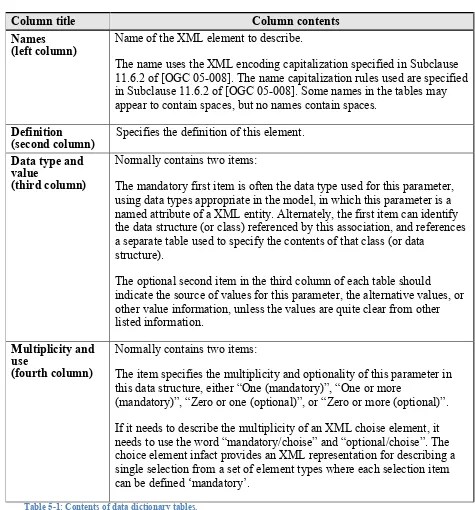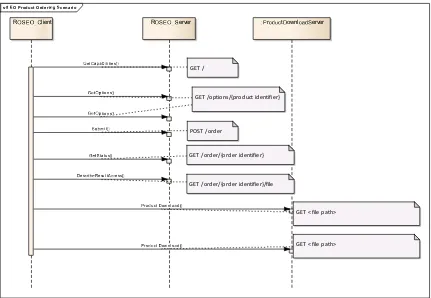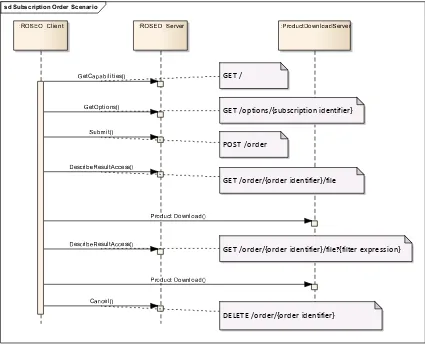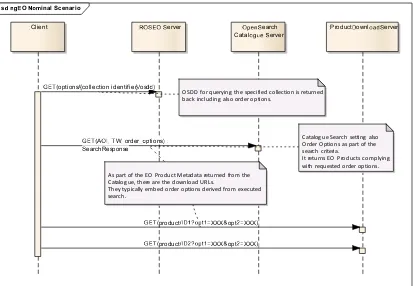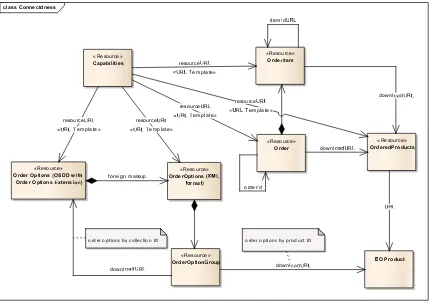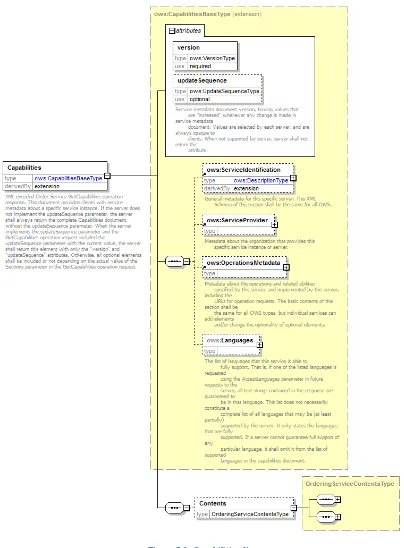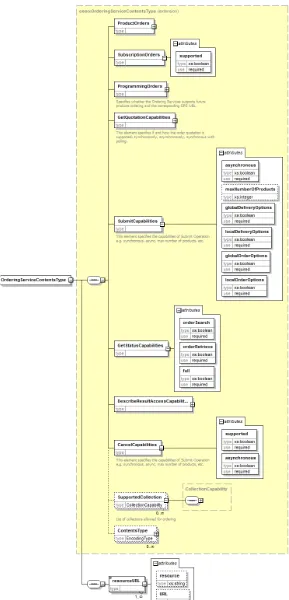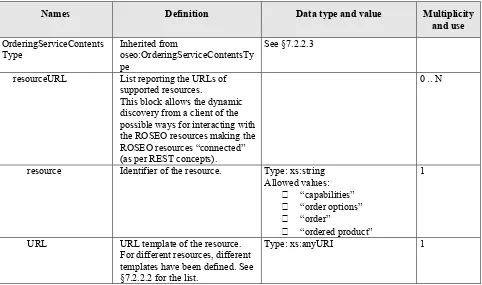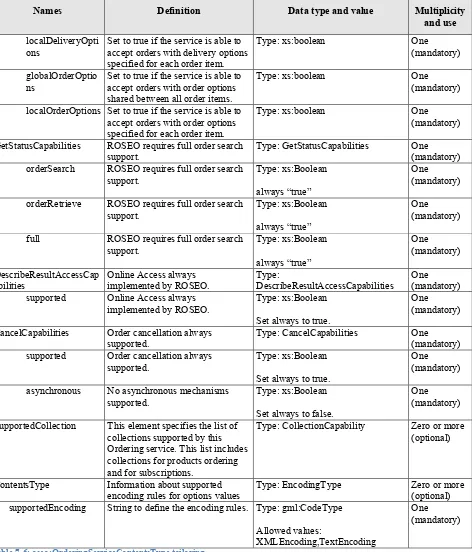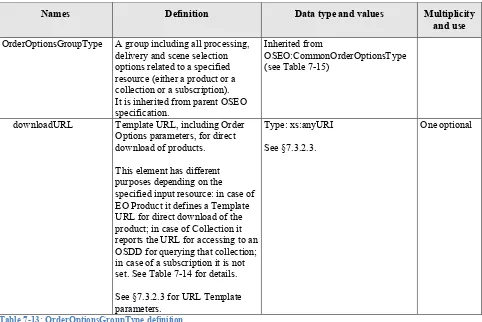Open Geospatial Consortium
Submission Date: 2013-09-03
Approval Date: 2014-03-29
Publication Date: 2014-04-28
External identifier of this OGC® document: http://www.opengis.net/doc/BP/roseo/1.0
Internal reference number of this OGC® document: 13-042
Version: 1.0
Category: OGC® Best Practice
Editor: Daniele Marchionni
OGC RESTful Encoding of Ordering Services Framework
For Earth Observation Products
Copyright notice
Copyright © 2014 Open Geospatial Consortium
To obtain additional rights of use, visit http://www.opengeospatial.org/legal/.
Warning
This document defines an OGC Best Practices on a particular technology or approach related to an OGC standard. This document is not an OGC Standard and may not be referred to as an OGC Standard. It is subject to change without notice. However, this document is an official position of the OGC membership on this particular technology topic.
Document type: OGC® Best Practice Document subtype: if applicable
License Agreement
Permission is hereby granted by the Open Geospatial Consortium, ("Licensor"), free of charge and subject to the terms set forth below, to any person obtaining a copy of this Intellectual Property and any associated documentation, to deal in the Intellectual Property without restriction (except as set forth below), including without limitation the rights to implement, use, copy, modify, merge, publish, distribute, and/or sublicense copies of the Intellectual Property, and to permit persons to whom the Intellectual Property is furnished to do so, provided that all copyright notices on the intellectual property are retained intact and that each person to whom the Intellectual Property is furnished agrees to the terms of this Agreement.
If you modify the Intellectual Property, all copies of the modified Intellectual Property must include, in addition to the above copyright notice, a notice that the Intellectual Property includes modifications that have not been approved or adopted by LICENSOR. THIS LICENSE IS A COPYRIGHT LICENSE ONLY, AND DOES NOT CONVEY ANY RIGHTS UNDER ANY PATENTS THAT MAY BE IN FORCE ANYWHERE IN THE WORLD.
THE INTELLECTUAL PROPERTY IS PROVIDED "AS IS", WITHOUT WARRANTY OF ANY KIND, EXPRESS OR IMPLIED, INCLUDING BUT NOT LIMITED TO THE WARRANTIES OF MERCHANTABILITY, FITNESS FOR A PARTICULAR PURPOSE, AND NONINFRINGEMENT OF THIRD PARTY RIGHTS. THE COPYRIGHT HOLDER OR HOLDERS INCLUDED IN THIS NOTICE DO NOT WARRANT THAT THE FUNCTIONS CONTAINED IN THE INTELLECTUAL PROPERTY WILL MEET YOUR REQUIREMENTS OR THAT THE OPERATION OF THE INTELLECTUAL PROPERTY WILL BE
UNINTERRUPTED OR ERROR FREE. ANY USE OF THE INTELLECTUAL PROPERTY SHALL BE MADE ENTIRELY AT THE USER’S OWN RISK. IN NO EVENT SHALL THE COPYRIGHT HOLDER OR ANY CONTRIBUTOR OF
Contents
1. Scope ... 16
2. Conformance ... 18
3. References ... 20
4. Terms and Definitions ... 22
5. Conventions ... 24
5.1 Abbreviated terms ... 24
5.2 UML notation ... 25
5.2.1 Introduction ... 25
5.2.2 UML Class Diagrams ... 26
5.2.3 UML Sequence Diagrams ... 28
5.3 XML notation ... 29
5.4 Used parts of other documents ... 30
5.5 Data dictionary tables ... 31
6. RESTful Encoding of Ordering Services Framework For Earth Observation Products (ROSEO) Overview ... 33
6.1 RPC view of ROSEO ... 33
6.2 Resource View of ROSEO ... 34
6.3 Essential Use-cases ... 36
6.3.1 Ordering from catalogue of EO Products ... 36
6.3.2 Subscribe to EO Products ... 37
6.3.3 Direct Download from Catalogue ... 39
7. ROSEO – Resource Model ... 41
7.1 Resource Root Path ... 41
7.2 Capabilities Resource ... 41
7.2.2 Definition ... 42
7.2.2.1 Contents ... 46
7.2.2.2 Resource URL Templates ... 47
7.2.2.3 oseo:OrderingServiceContentsType ... 49
7.2.2.4 CollectionCapability ... 52
7.2.3 HTTP Methods ... 53
7.2.3.1 Examples ... 53
7.2.4 Error Handling ... 56
7.3 Order Options Resource ... 57
7.3.1 URL ... 58
7.3.2 Definition ... 59
7.3.2.1 Order Options in canonical XML format ... 59
7.3.2.1.1 OrderOptionsGroupType ... 60
7.3.2.2 Order Options in Open Search Description Document format ... 63
7.3.2.2.1 Open Search Description Document Extension for Order Options 63 7.3.2.3 Open Search Template URL for Order Options ... 68
7.3.2.3.1 URL encoding rule for OSEO Order Options ... 68
7.3.2.3.2 URL Template Search Operators ... 70
7.3.2.3.3 Predefined Order Options URL Template Parameters ... 71
7.3.2.4 Examples ... 88
7.3.2.4.1 OrderOptions By Product (Canonical XML format) ... 88
7.3.2.4.2 OrderOptions By Product (OSDD format) ... 91
7.3.2.4.3 OrderOptions By Collection (Canonical XML format) ... 94
7.3.2.4.4 OrderOptions By Collection (OSDD format) ... 97
7.3.2.4.5 OrderOptions By Subscription (Canonical XML format) ... 101
7.3.3 HTTP Methods ... 103
7.3.3.1 Examples ... 103
7.3.4 Error Handling ... 104
7.4 Order Resource ... 105
7.4.1 URL ... 105
7.4.1.1.1 Open Search Template URL for Order Search ... 106
7.4.2 Definition ... 108
7.4.2.1 CommonOrderMonitorSpecification ... 109
7.4.2.2 OSEO:DeliveryOptionsType ... 111
7.4.2.3 CommonOrderStatusItemType ... 113
7.4.2.4 Examples ... 116
7.4.2.4.1 Submitted EO Product Order (3 items) ... 116
7.4.2.4.2 Submitted Subscription Order ... 118
7.4.2.4.3 Retrieved Order ... 119
7.4.3 HTTP Methods ... 121
7.4.3.1 Examples ... 121
7.4.3.1.1 Submit Product Order ... 121
7.4.3.1.2 Get Order By ID ... 122
7.4.3.1.3 Get Order Item By ID ... 124
7.4.3.1.4 Get Order By Filter Expression ... 125
7.4.3.1.5 Order Cancellation ... 127
7.4.4 Error Handling ... 127
7.5 Ordered Product Resource ... 129
7.5.1 URL ... 129
7.5.2 Definition ... 129
7.5.2.1 Examples ... 132
7.5.3 HTTP Methods ... 133
7.5.3.1 Examples ... 133
7.5.3.1.1 Get all ordered products ... 133
7.5.3.1.2 Get order item products ... 133
7.5.3.1.3 Get all ordered products generated since a date ... 134
7.5.4 Error Handling ... 134
8. ROSEO “Core” Requirement Class ... 136
8.1 Capabilities ... 136
8.3 Order ... 142
8.4 Ordered Product ... 146
9. ROSEO “SceneSelection” Requirement Class ... 149
9.1 Capabilities ... 149
9.2 Order Options ... 149
9.3 Order ... 149
9.4 Ordered Product ... 150
10. ROSEO “SubscriptionOrder” Requirement Class ... 151
10.1 Capabilities ... 151
10.2 Order Options ... 151
10.3 Order ... 152
10.4 Ordered Product ... 153
11. Annex A: Conformance Class Abstract Test Suite (Normative) ... 154
11.1 Conformance class: Core (http://www.opengis.net/spec/ROSEO/1.0/conf/Core) 154 11.1.1 GET Capabilities ... 154
11.1.2 GET Capabilities/ServiceIdentification ... 156
11.1.3 GET Capabilities/ServiceProvider ... 157
11.1.4 GET Capabilities/Contents ... 157
11.1.5 GET Capabilities/non_nominal_conditions ... 158
11.1.6 GET OrderOptions/xml/product_id ... 159
11.1.7 GET OrderOptions/xml/collection_id ... 160
11.1.8 GET OrderOptions/osdd/product_id ... 161
11.1.9 GET OrderOptions/osdd/collection_id ... 162
11.1.10 GET OrderOptions/non_nominal_conditions ... 163
11.1.12 POST Order/non_nominal_conditions ... 165
11.1.13 GET Order/ID ... 166
11.1.14 GET Order/orderItem/ID ... 167
11.1.15 GET Order/LastUpdate ... 168
11.1.16 GET Order/OrderStatus ... 170
11.1.17 GET Order/OrderReference ... 171
11.1.18 GET Order/LastUpdate&OrderStatus&OrderReference ... 172
11.1.19 GET Order/non_nominal_conditions ... 174
11.1.20 DELETE Order ... 175
11.1.21 GET Order/cancellation ... 175
11.1.22 DELETE Order/non_nominal_conditions ... 176
11.1.23 GET OrderedProduct/all ... 177
11.1.24 GET OrderedProduct/orderItem ... 178
11.1.25 GET OrderedProduct/LastUpdate ... 179
11.1.26 GET OrderedProduct/non_nominal_conditions ... 179
11.2 Conformance class: SceneSelection (http://www.opengis.net/spec/ROSEO/1.0/conf/SceneSelection) ... 180
11.2.1 GET OrderOptions/xml ... 180
11.2.2 POST Order ... 181
11.2.3 POST Order/non_nominal_conditions ... 183
11.2.4 GET Order/ID ... 184
11.3 Conformance class: SubscriptionOrder (http://www.opengis.net/spec/ROSEO/1.0/conf/SubscriptionOrder) ... 185
11.3.1 GET Capabilities ... 185
11.3.2 GET OrderOptions/xml ... 186
11.3.4 GET Order/ID ... 188
11.3.5 GET OrderedProduct/all ... 189
11.4 Traceability Matrix ... 190
11.4.1 Requirements vs. Conformance Tests Traceability Matrix ... 190
11.4.2 Conformance Tests vs. Requirements Traceability Matrix ... 196
12. Annex B: ESA Sentinel-1 Order Options ... 202
13. Annex C: ESA Sentinel-2 Order Options ... 217
14. Annex D: ESA Sentinel-3 Order Options ... 222
15. Annex E: Revision history ... 242
16. Annex F: Bibliography ... 243
Index of figures
Figure 2-1: ROSEO Requirement Classes. ... 18Figure 5-1: UML Class Diagram notations. ... 28
Figure 5-2: UML Sequence Diagram notiations. ... 29
Figure 6-1: Ordering products from EO Catalogue Scenario. ... 36
Figure 6-2: Subscribing to EO products Scenario. ... 38
Figure 6-3 Direct Download from Catalogue Scenario. ... 39
Figure 7-1: Links between ROSEO resources. ... 42
Figure 7-2: Capabilities diagram. ... 43
Figure 7-3: OrderingServiceContentsType diagram. ... 46
Figure 7-4: CollectionCapability diagram. ... 52
Figure 7-5: OrderOptions resource links. ... 58
Figure 7-6: OrderOptions diagram. ... 59
Figure 7-7: OrderOptionsGroupType diagram. ... 60
Figure 7-9: Orders diagram. ... 108
Figure 7-10: Order diagram. ... 108
Figure 7-11: CommonOrderMonitorSpecification diagram. ... 109
Figure 7-12: OSEO:DeliveryOptionsType diagram. ... 111
Figure 7-13: CommonOrderStatusItemType diagram. ... 113
Figure 7-14: OrderedProducts diagram. ... 129
Figure 7-15: URL diagram. ... 130
Index of Tables
Table 2-1: ROSEO Requirement Classes. ... 19
Table 5-1: Contents of data dictionary tables. ... 32
Table 7-1: Capabilities Resource URLs. ... 42
Table 7-2: Capabilities definition. ... 44
Table 7-3: ServiceIdentification tailoring. ... 45
Table 7-4: OrderingServiceContentsType definition. ... 47
Table 7-5: Resource Template URLs. ... 49
Table 7-6: oseo:OrderingServiceContentsType tailoring. ... 51
Table 7-7: CollectionCapability tailoring. ... 53
Table 7-8: Capabilities Resource Methods. ... 53
Table 7-9: Capabilities resource error conditions. ... 56
Table 7-10: Order Options Resource URLs. ... 58
Table 7-11: Order Options Resource URLs parameters. ... 58
Table 7-12: OrderOptions definition. ... 59
Table 7-13: OrderOptionsGroupType definition. ... 61
Table 7-14: downloadURL element details for the different order resources. ... 61
Table 7-15: OSEO:CommonOrderOptionsType tailoring. ... 63
Table 7-16: OSEO:ProtocolType tailoring. ... 63
Table 7-17: Order Options definition in OSDD tailoring. ... 67
Table 7-18: Open Search Template URL details for the different order resources. ... 68
Table 7-19: Example Order Options declaration. ... 69
Table 7-20: Example Order Option setting (simple). ... 70
Table 7-21: Example Order Option setting (complex). ... 70
Table 7-23: Open Search Template Parameters for Product Order Options (from OGC
06-141r6). ... 78
Table 7-24: New Product Order Options. ... 79
Table 7-25: Open Search Template Parameters for Subscription Order Options. ... 81
Table 7-26: Open Search Template Parameters for Scene Selection Order Options (from OGC 06-141r6). ... 87
Table 7-27: Order Options Resource Methods. ... 103
Table 7-28: OrderOptions GET parameters. ... 103
Table 7-29: Order Options resource error conditions. ... 104
Table 7-30: Order Resource URLs. ... 105
Table 7-31: Order Resource URLs parameters. ... 106
Table 7-32: ORDER SEARCH Template URL parameters. ... 107
Table 7-33: Orders definition. ... 108
Table 7-34: CommonOrderMonitorSpecification definition. ... 110
Table 7-35: OSEO:CommonOrderSpecification tailoring. ... 111
Table 7-36: OSEO:DeliveryOptionsType tailoring. ... 112
Table 7-37: CommonOrderStatusItemType definition. ... 114
Table 7-38: OSEO:CommonOrderItemType tailoring. ... 116
Table 7-39: Order Resource Methods. ... 121
Table 7-40: Order GET parameters. ... 121
Table 7-41: Order resource error conditions. ... 128
Table 7-42: Ordered Products Resource URLs. ... 129
Table 7-43: Ordered Products Resource URLs parameters. ... 129
Table 7-44: Ordered Products Filter expression parameters. ... 129
Table 7-45: OrdredProducts definition. ... 130
Table 7-47: OSEO:OnLineAccessAddressType tailoring. ... 132
Table 7-48: Ordered Products Resource Methods. ... 133
Table 7-49: Ordered Products GET parameters. ... 133
Table 7-50: Ordered Product resource error conditions. ... 135
Table 11-1: ROSEO Requirement vs. Conformance Classes. ... 154
Table 11-2: Requirements vs. Conformance Tests Traceability Matrix. ... 195
Table 11-3: Conformance Tests vs. Requirements Traceability Matrix. ... 201
Table 12-1: Sentinel-1 Order Options definition. ... 212
Table 13-1: Sentinel-2 Order Options definition. ... 218
Table 14-1: Sentinel-1 order option analysis by Dataset. ... 222
i.
Abstract
This OGC Best Practices document specifies the interfaces, bindings, requirements, conformance classes that enable complete workflows for ordering Earth Observation (EO) data products. In fact it provides the interfaces for supporting the following EO Product ordering scenarios:
Ordering products from EO Catalogues
Subscribing to automatic delivery of EO products
Bulk EO Product orders
The EO products orders can be delivered on file via different online protocols (e.g. ftp, sftp, ftps, etc.).
The ordered items can be customized in detail, one by one or altogether, via the
processing options and scene selection options. These options are dynamically discovered and set from the clients by calling appropriate methods of Ordering Services resources. This specification includes a comprehensive list of processing options (Table 7-25) and scene selection options (Table 7-26) derived from the parent specification OGC 06-141r6 which gathered inputs from several Satellite Agencies and Operators:
ESA
EUMETSAT
CNES
DLR
CSA
SPOT Image
In case these already identified options are not sufficient for the specific mission, they can be extended following the SWE Common 2.0 framework. In Annex A, B, C there are possible examples for new ESA Sentinel missions.
This document is based on the standard:
OGC 06-141r6 Ordering Services Framework for Earth Observation Products Interface Standard V1.0.0
That was initially produced during the ESA HMA (Heterogeneous Missions Accessibility) initiative [OR1] and related projects.
With respect to the parent specification this Best Practice document proposes the following changes:
focusing on operations and in fact the OGC 06-141r6 is structured in Web Service operations.
Usage of OpenSearch Description Documents as alternate method for describing Ordering Options (§7.3.2.2). This specification uses the order options model already described in the OGC 06-141r6 standard, with some minor updates, that is now referred as “Canonical XML format”, but defines also an additional method for describing order options within Open Search Description Documents. Actually this part of the specification can be considered as an Open Search extension for order options. This part of the specification is meant to be used when the EO products can be directly downloaded after a catalogue interaction with possible application of some order options (§6.3.3).
Simplification of the interfaces focusing on a sub-set of the scenarios supported by the parent specification: no future products orders supported, no orders on media.
ii.
Keywords
The following are keywords to be used by search engines and document catalogues. ogcdoc, OGC document, best practice, oseo, rest, eo, opensearch, order
iii.
Preface
This OGC Best Practices document specifies the interfaces for issuing EO products orders in different flavors (e.g. Order from Catalogue, Subscription, etc.) and with a lot of flexibility (order options, scene selection options).
Due to the number of supported ordering scenarios, covering different and also
alternative needs, then a number of Requirements Classes have been defined collecting the specific requirements a conformant implementation has to comply with. In parallel a number of Conformance Classes have been defined regrouping all tests a server has to pass for claiming the compliance with the corresponding Requirement Class. A server can comply with some Requirement Classes, it is not required to implement all classes. Implementers shall be aware that:
Not all scenarios (Requirement Classes) shall be implemented, but only the Core one plus the others that are necessary for their use cases (see §2). However a server has to specify the supported Conformance Classes as evidence of the provided functionality.
If order options are supported, then the implementation has to use a sub-set of the already identified ones unless they are not fitting with their needs; in that case an application profile listing the new ones, to be modeled with SWE Common 2.0, has to be defined and implemented.
functionality of the specification, but can be used for accommodating
implementation specific needs and then allowing the definition of “extensions”. Attention is drawn to the possibility that some of the elements of this document may be the subject of patent rights. The Open Geospatial Consortium shall not be held
responsible for identifying any or all such patent rights.
Recipients of this document are requested to submit, with their comments, notification of any relevant patent claims or other intellectual property rights of which they may be aware that might be infringed by any implementation of the standard set forth in this document, and to provide supporting documentation.
iv.
Submitting organizations
The following organizations submitted this Document to the Open Geospatial Consortium (OGC):
ESA – European Space Agency
Telespazio
v.
Submitters
All questions regarding this submission should be directed to the editor or the submitters:
Name Affiliation
1.
Scope
The scope of this Best Practice document is to describe the interfaces for issuing orders for Earth Observation Products. It allows preparing different types of orders:
Order by precisely identified items: the items to be ordered are identified via a search against a companion EO Catalogue (not part of this specification), then an order can be built specifying the product identifiers returned by the catalogue.
Bulk Orders: the items to be ordered are specified via filter expression rather than specifying the items one by one as at step before. Ths filter expression is defined via ad hoc order options.
Product Subscription: similar to bulk orders, but there is also the periodicity: products are delivered several times, whenever thay match the subscription parameters.
The ordered items are delivered online to the users via direct download of ordered items. No media delivery is included in this ordering specification.
This specification allows a fine grained customization of ordered items by supporting flexible Order Options. Order Options are basically modeled via SWE Common 2.0 framework, which allows a flexible declaration of the different parameters (e.g. specifying the possible type, allowed values, default values and allowing also the structuring of options in arrays, structures, choices, etc.) and then a simple setting of values once the order is prepared. More precisely this specification allows to specify:
processing options e.g.: processing level, format, band selections, polarization selection, etc.
delivery options e.g.: protocol
scene selection options e.g.: ordered items can be sub-set according to the used needs.
Order Options are declared and set in two different formats:
“Order Options in Canonical XML format” (§7.3.2.1): it is the format defined in the parent Standard OGC 06-141r6, represented by the oseo:OrderOptions element, which is a complex structure regrouping order, delivery and scene selection options defined via SWE Common.
“Order Options in Open Search Description Document format” (§7.3.2.2): order options are declared in the OpenSearch Template URL similarly to the other query parameters, but an order option element in “Canonical XML format” is embedded as foreign mark-up in the Open Search Description Document in order to provide the information that a simple template parameter is not able to describe e.g. type, allowed values, default values etc.
OGC 06-141r6 Ordering Services Framework for Earth Observation Products Interface Standard V1.0.0
for replacing SOAP with REST. Additionally to REST replacement of SOAP, further modifications have been done:
Removed order of products derived from a programming request. This document focuses only on products from archive.
Removed support for order quotation, function very rarely used from operational implementations of OSEO specification.
Removed support for asynchronous notifications: in fact this document focuses on Web Applications in general and on REST approach in particular, while the asynchronous message exchange is more a SOAP Web Service Oriented function.
Simplified delivery mechanism: only direct download from URL (HTTP GET) is supported: delivery via media and via FTP no longer supported.
The REST encoding affected also the way the document is presented. In fact according to REST philosophy, the service is described in term of Resources and Methods applied on them rather than in terms of operations as the parent specification did. From Resource perspective, this Best Practice document defines the following resources:
Capabilities (§7.2), which is the resource document returing description of the service.
Order Options (§7.3), which is the resource describing the options for preparing an order for a specified item.
Order (§7.4), which is an EO Product order created on the server.
Ordered Product (§7.5), which are the products to be delivered to the users as result of the Order creation (submission).
For each resource, the document specifies:
The definition, via XML schema, of the various items composing the resource.
The HTTP Methods available (according to the REST – Uniform Interface concept) e.g. GET, POST, DELETE.
The HTTP URLs for accessing to the resource.
And the connections with the other resources (according to the REST – Connectdness concept).
The section §6 provides a more detailed description of the REST approach for this specification and the mapping with the parent Standard document.
2.
Conformance
This Best Practice document defines the interfaces and the requirements for implementing a server supporting the ordering of Earth Observation Products. Because Earth Observation Products can be ordered in different ways through the preparation and submission of different types of orders:
Product Order: order listing the different EO products by providing their identifier and options;
Subscription Order: order specifying the periodical delivery of loosely defined products.
Therefore different Requirement Classes have been defined specifying the requirements for implementing the ordering process for each of the identified order types. Moreover additional classes have been considered for defining optional functions that might be implemented by servers having extended functionality.
The complete list of Requirements Classes is listed below:
Core, which specifies the minimum behaviour that all ROSEO servers shall implement. It includes the support of ordering of precisely identified Earth Observation Products.
SceneSelection, which specifies the additional requirements a ROSEO server has to comply for supporting scene selection.
SubscriptionOrder, which specifies the additional requirements a ROSEO server shall implement for supporting subscription orders.
The following diagram shows the relationships between the defined Requirement Classes.
Figure 2-1: ROSEO Requirement Classes.
class Dow nloadProtocol
«Requirement Class»
Core
«Requirement Class»
SceneSelection
«Requirement Class»
The inheritance relationship between the different classes represents the inheritance of all requirements from the super class. E.g.: SceneSelection class defines its specific
requirements and includes also the requirements defined in the Core class, hence a Server claiming the compliance with SceneSelection class has to comply with SceneSelection plus Core class requirements.
The following table reports:
o The Requirement Class name
o the URI
o the dependency with other requirements classes.
Requirement Class
Requirement Class URI Dependency
Core http://www.opengis.net/spec/ROSEO/1.0/req/Core
SceneSelection http://www.opengis.net/spec/ROSEO/1.0/req/SceneSelection Core
SubscriptionOrder http://www.opengis.net/spec/ROSEO/1.0/req/SubscriptionOrder Core
Table 2-1: ROSEO Requirement Classes.
The root path of all Requirements and conformance test URIs defined in this document is:
http://www.opengis.net/spec/ROSEO/1.0/
Conformance with this Best Practice document shall be checked using all the relevant tests specified in Annex A: Conformance Class Abstract Test Suite (Normative) of this document. The framework, concepts, and methodology for testing, and the criteria to be achieved to claim conformance are specified in the OGC Compliance Testing Policies and Procedures and the OGC Compliance Testing web site1.
In order to conform to this OGC™interface standard, a software implementation shall choose to implement at least Core class and optionally the other classes.
A server that complies only with Core is a server supporting ordering of precisely identified products.
All requirements-classes and conformance-classes described in this document are owned by the standard(s) identified.
3.
References
The following normative documents contain provisions that, through reference in this text, constitute provisions of this document. For dated references, subsequent
amendments to, or revisions of, any of these publications do not apply. For undated references, the latest edition of the normative document referred to applies.
[NR1] W3C Recommendation January 1999, Namespaces In XML, http://www.w3.org/TR/2000/REC-xml-names.
[NR2] W3C Recommendation 6 October 2000, Extensible Markup Language (XML) 1.0 (Second Edition), http://www.w3.org/TR/REC-xml
[NR3] W3C Recommendation 2 May 2001: XML Schema Part 0: Primer, http://www.w3.org/TR/2001/REC-xmlschema-0-20010502/
[NR4] W3C Recommendation 2 May 2001: XML Schema Part 1: Structures, http://www.w3.org/TR/2001/REC-xmlschema-1-20010502/
[NR5] W3C Recommendation 2 May 2001: XML Schema Part 2: Datatypes, http://www.w3.org/TR/2001/REC-xmlschema-2-20010502/
[NR6] OWS Common Implementation Specification, May 2005 OGC 05-008c1 [NR7] OpenGIS® Web Services Common Specification OGC 06-121r9
[NR8] Ordering Services Framework for Earth Observation Products Interface Standard OGC 06-141r6
[NR9] The Extensible Markup Language (XML), World Wide Web Consortium, http://www.w3.org/TR/1998/REC-xml-19980210
[NR10] New OGC Document Template Draft OGC 10-176r4
[NR11] Guidance to Editors and Authors of OGC Documents that use the OGC Standards document template OGC 10-177r3
[NR12] Policy Directives for Writing and Publishing OGC Standards: TC Decisions OGC 06-135r11
[NR13] The Specification Model — A Standard for Modular specifications OGC 08-131r3
[NR15] OASIS searchRetrieve: Part 4. APD Binding for OpenSearch Version 1.0
http://docs.oasis-open.org/search-ws/searchRetrieve/v1.0/os/part4-opensearch/searchRetrieve-v1.0-os-part4-opensearch.html [NR16] JSON (JavaScript Object Notation) http://www.json.org/
Other references:
[OR1] Heterogeneous Missions Accessibility – Design Methodology, Architecture and Use of Geospatial Standards for the Ground Segment Support of Earth
Observation missions ESA TM-21
4.
Terms and Definitions
This document uses the terms defined in Sub-clause 5.3 of [OGC 06-121r8], which is based on the ISO/IEC Directives, Part 2, Rules for the structure and drafting of
International Standards. In particular, the word “shall” (not “must”) is the verb form used to indicate a requirement to be strictly followed to conform to this standard.
For the purposes of this document, the following additional terms and definitions apply.
dataset series (dataset collection )
Collection of datasets sharing the same product specification [ISO 19113, ISO 19114, ISO 19115]. In this context, a collection metadata record in the catalogue describes a collection of EO Products, typically a dataset collection corresponds to datasets (i.e. products) generated by a single sensor in a specific mode on a particular EO satellite.
EO Product
Data product, typically stored on computer file, generated by sensors carried by Earth Observation Satellites.
identifier
a character string that may be composed of numbers and characters that is exchanged between the client and the server with respect to a specific identity of a resource.
profile
set of one or more base standards and - where applicable - the identification of chosen clauses, classes, subsets, options and parameters of those base standards that are necessary for accomplishing a particular function [ISO 19101, ISO 19106]
procedure oriented architectural style
platform-independent design approach that is focused on operations, their parameters and their results, that can be defined in an abstract level specification. Concrete platform dependent specifications can be derived from the abstract level, allowing, for example, KVP or SOAP messaging.
product order
resource oriented architectural style
platform-independent design approach that is focused on resources, representations and actions, that can be defined in an abstract level specification. Concrete platform
dependent specifications can be derived from the abstract level, allowing, for example, a RESTful architecture.
subscription
ordering request, issued via this specification, allowing the client to adhere to the periodical delivery of products processed and delivered according to predefined rules.
URL component
text contained after the context path between two forward slashes “/”, that are not placed between two matching parentheses “(...)”, and before any question mark character “?”
URL component key
text contained in an URL component that comes before an opening parenthesis “(“
URL component value
text contained in an URL component that is enclosed between the first opening parenthesis “(“ and the last closing parenthesis “)” in the → component
Example In the http://example.org/component1/componentKey(componentValue), components are as follows:
Context Path: http://example.org/
URL Components: component1, componentKey(componentValue) URL Component Keys: component1, componentKey
5.
Conventions
This sections provides details and examples for any conventions used in the document. Examples of conventions are symbols, abbreviations, use of XML schema, or special notes regarding how to read the document.
5.1 Abbreviated terms Acronym Definition
ANX Ascending Node Crossing API Application Program Interface COTS Commercial Off The Shelf
CQL Common Query Language
CRS Coordinate Reference System CSW Catalogue Service-Web
DCE Distributed Computing Environment DCP Distributed Computing Platform DDS Data Dissemination Service DNX Descending Node Crossing
EO Earth Observation
HMA Heterogeneous Missions Accessibility HTTP Hyper Text Transport Protocol
ISO International Organisation for Standardisation JSON JavaScript Object Notation
OGC Open GIS Consortium
OSDD Open Search Description Document OSEO Ordering Services Framework for Earth
Acronym Definition
ROSEO RESTful Encoding of Ordering Services Framework for Earth Observation Products SOAP Simple Object Access Protocol
SQL Structured Query Language SWG Standard Working Group UML Unified Modeling Language URI Uniform Resource Identifier URL Uniform Resource Locator URN Uniform Resource Name
UTF-8 Unicode Transformation Format-8 WSDL Web Service Definition Language W3C World Wide Web Consortium XML eXtensible Markup Language
5.2 UML notation
5.2.1 Introduction
Some diagrams that appear in this document are presented using the Unified Modeling Language (UML) diagrams:
Class Diagrams
Class diagrams show the static structure of the model, in particular, the things that exist (such as classes and types), their internal structure, and their relationships to other things. Class diagrams do not show temporal information, although they may contain occurrences of things that have or describe temporal behavior.
Sequence Diagrams
A sequence diagram shows an interaction arranged in time sequence. In
5.2.2 UML Class Diagrams
A class diagram is a picture providing generic descriptions of possible systems. Class diagrams and object diagrams are alternate representations of object models. Class diagrams contain classes and object diagrams contain objects, but it is possible to mix classes and objects when dealing with various kinds of metadata, so the separation is not rigid. Class diagrams contain icons representing classes, interfaces, and their
relationships. In particular, class diagrams contain:
Logical Packages
Packages purpose is to partition the logical model of a system. They are clusters of highly related classes that are themselves cohesive, but are loosely coupled with other such clusters. You can use packages to group classes, interfaces, and other packages.
Classes
A class captures the common structure and common behavior of a set of objects. A class is an abstraction of real-world items. When these items exist in the real world, they are instances of the class, and referred to as objects.
Interfaces
An interface specifies the externally visible operations of a class and/or
component, and has no implementation of its own. An interface typically specifies only a limited part of the behavior of a class or component.
Parameterized Classes
A parameterized class is a template for creating any number of instantiated classes that follow its format. It declares formal parameters. You can use other classes, types, and constant expressions as parameters. You cannot use the parameterized class itself as a parameter. You must instantiate a parameterized class before you can create its objects. In its simplest form, you can use parameterized classes to build container classes.
Instantiated Classes
An instantiated class is a class formed from a parameterized class by supplying actual values for parameters. It is created by supplying actual values for the formal parameters of the parameterized class. This instantiation process forms a concrete class in the family of the parameterized class. The instantiated class should be put at the client end of an instantiate relationship (accessible through the Create Entry on the Tools menu) that points to the corresponding
parameterized class.
An association represents a semantic connection between two classes, or between a class and an interface. Associations are bi-directional; they are the most general relationship and also the most semantically weak.
Aggregate Relationship
The aggregate relationship is used for showing a whole and part relationship between two classes.
The class at the client end of the aggregate relationship is sometimes called the aggregate class. An instance of the aggregate class is an aggregate object. The class at the supplier end of the aggregate relationship is the part whose instances are contained or owned by the aggregate object. The aggregate relationship is used for showing that the aggregate object is physically constructed from other objects or that it logically contains another object. The aggregate object has ownership of its parts.
Generalize/Inherits Relationships
A generalize relationship between classes shows that the subclass shares the structure or behavior defined in one or more super-classes. Use a generalize relationship to show an "is- a" relationship between classes.
Instantiates Relationships
An instantiates relationship represents the act of substituting actual values for the parameters of a parameterized class or parameterized class utility to create a specialized version of the more general item. In most cases, you will also draw a uses relationship between the instantiated class and another concrete class that is used as an actual parameter.
Dependency Relationships
Draw a dependency relationship between two classes, or between a class and an interface, to show that the client class depends on the supplier class/interface to provide certain services, such as:
o The client class accesses a value (constant or variable) defined in the supplier class/interface.
o Operations of the client class invoke operations of the supplier class/interface.
o Operations of the client class have signatures whose return class or arguments are instances of the supplier class/interface.
Figure 5-1: UML Class Diagram notations.
5.2.3 UML Sequence Diagrams
Sequence diagrams are a representation of an interaction between objects. A sequence diagram traces the execution of an interaction in time.
The picture below illustrates a sequence diagrams.
cla ML otations Diaras
Package1
«interface» Interface1
Class1
Class2
p1 : t1 Class3
«istantiated class» Class4
Class5 Class6
SuperClass
SubClass_A SubClass_B
assoiatio
«n
Figure 5-2: UML Sequence Diagram notiations.
Each interaction between objects is the activation of an operation of an object, which includes input and output parameters.
5.3 XML notation
Most diagrams that appear in this specification are presented using an XML schema notation defined by the XMLSpy tool and described in this subclause.
Hereafter the symbols defined in the XML schema notation are described:
o Optional single element without child elements
o Optional single element with child elements
o Mandatory single element.
o Mandatory multiple element containing child elements. This element must occur at least once (Minimum Occurrence = 1) and may occur as often as desired (Maximum Occurrence = unbounded).
o Mandatory single element with containing simple content (e.g. text) or mixed complex content (e.g. text with xhtml markup).
sdeqnce Diagamsotations
Actr
Oject Oject
ratiA ()
o A sequence of elements. The elements must appear exactly in the sequence in which they appear in the schema diagram.
o A choice of elements. Only a single element from those in the choice may appear at this position.
o Types. If an element refers to a complex global type, the type is shown with a border and yellow background.
o Complex Type. The following figure illustrates the use of a complex type for defining an XML element
5.4 Used parts of other documents
This document uses significant parts of documents:
Ordering Services Framework for Earth Observation Products Interface Standard OGC 06-141r6
In fact this present document is a different encoding (based on REST) of that already existing standard.
To reduce the need to refer to that document, this document copies some of those parts with small modifications. To indicate those parts to readers of this document, it is used the reference [NR8].
5.5 Data dictionary tables
Column title Column contents Names
(left column)
Name of the XML element to describe.
The name uses the XML encoding capitalization specified in Subclause 11.6.2 of [OGC 05-008]. The name capitalization rules used are specified in Subclause 11.6.2 of [OGC 05-008]. Some names in the tables may appear to contain spaces, but no names contain spaces.
Definition (second column)
Specifies the definition of this element.
Data type and value
(third column)
Normally contains two items:
The mandatory first item is often the data type used for this parameter, using data types appropriate in the model, in which this parameter is a named attribute of a XML entity. Alternately, the first item can identify the data structure (or class) referenced by this association, and references a separate table used to specify the contents of that class (or data
structure).
The optional second item in the third column of each table should indicate the source of values for this parameter, the alternative values, or other value information, unless the values are quite clear from other listed information.
Multiplicity and use
(fourth column)
Normally contains two items:
The item specifies the multiplicity and optionality of this parameter in this data structure, either “One (mandatory)”, “One or more
(mandatory)”, “Zero or one (optional)”, or “Zero or more (optional)”. If it needs to describe the multiplicity of an XML choise element, it needs to use the word “mandatory/choise” and “optional/choise”. The choice element infact provides an XML representation for describing a single selection from a set of element types where each selection item can be defined ‘mandatory’.
Table 5-1: Contents of data dictionary tables.
6.
RESTful Encoding of Ordering Services Framework For Earth
Observation Products (ROSEO) Overview
As highlighted in the introduction sections, this document provides a simplified and RESTful encoding of the parent specification Ordering Services Framework For Earth Observation Products OGC 06-141r6.
This is a RESTful specification and as such is described in terms of resources. However, this Best Practice is derived from OGC 06-141r6, which is SOAP Web Service, and thus operations centric (“RPC style”). Both approaches have almost same functionality. Therefore, this best practice can be identically described from the two different point of view. This section summarizes this specification from both a Resource point of view and from RPC style point of view and explains how they relate to each other.
6.1 RPC view of ROSEO
ROSEO deals with the following information items:
Order options, which describe the possible ways (order options description) for configuring / customizing the ordered items.
This specification supports order options at EO product level, describing the options available for each single product; and order options at collection level, describing the order options for all products belonging to a given collection.
Order, which is the actual request submitted by the client listing all the ordered items including the chosen customizations (order options values).
This specification supports two types of orders:
o Product Order: order listing the different EO products by providing their identifier and options. The ordered EO products have been likely
identified via a previous search from a Catalogue of EO products.
o Subscription Order: this order allows the periodical reception of products of interest on the areas of interest or to issue orders for bulk of products.
From RPC perspective, this specification is composed of the following operations:
GetCapabilities, which allows a client to request and receive service metadata (or Capabilities) document that describes the abilities of the specific server
implementation (see §7.2.3).
GetOptions, which allows clients to retrieve the options for issuing an order:
o in case of subscriptions it returns the possible parameters to set for specifying the scope of the subscription (e.g.: area of interest, expiration date, etc.).
See §7.3.3.
Submit, which allows either submitting an order of products (from EO catalogue) or subscribing to a subscription (see §7.4.3).
This operation is “asynchronous” meaning that it starts the activation of the ordering process and returns a quick acknowledge reporting whether the submitted order has been accepted or not.
To verify whether the order has been successfully completed and to retrieve produced products, dedicated operations have to be called later on.
GetStatus, which allows to retrieve either the status of submitted orders or the status of subscribed subscriptions (see §7.4.3).
DescribeResultAccess, which allows accessing the ordered products ready for download (see §7.5.3).
Cancel allows either to ask the cancellation of an already submitted order or to unsubscribe a subscription (see §7.4.3).
This operation is “asynchronous” meaning that it starts the activation of the cancellation process and returns a quick acknowledge reporting whether the cancellation request has been accepted or not. To understand whether the order has been actually cancelled, the GetStatus operation has to be called later on.
6.2 Resource View of ROSEO
From “Resource” perspective, this specification is composed of the following resources:
Service Metadata: It describes the service capabilities, supported operations, supported collections, and other service capabilities (see §7.2).
The following HTTP methods are supported:
o GET : it returns the service metadata of the server.
Order Options: it specifies all possible valid combinations of options for ordering a specific product, or for ordering products of a specified EO Product collection or for subscribing to a subscription (see §7.3).
The following HTTP methods are supported:
o GET /options/{eo:identifier}: it returns the order options possible for that product. Same as GetOptions in the RPC view.
http://a9.com/-/opensearch/extensions/eo/1.0/
o GET /options/{collection identifier}: it returns the order options possible for all products of that collection. Same as GetOptions in the RPC view.
o GET /options/{subscription identifier}: it returns the order options possible for subscribing to that subscription. Same as GetOptions in the RPC view.
Order: it is an order submitted by the client. It includes the ordered products with the selected options in case of Product Orders, or a single subscription with the selected subscription options (see §7.4).
The following HTTP methods are supported:
o POST /order: it creates an order from the XML payload provided in the message body. The operation return the URL of the created order. Same as
Submit in the RPC view.
o GET /order/{order identifier}: it returns the XML representation of the order with the specified identifier. Order status information are returned with order itself. Same as GetStatus in the RPC view.
o GET /order?{filter expression}: it returns the XML representation of the list of orders complying with the specified filter expression. Order status information are returned with order itself. Same as GetStatus in the RPC view.
o DELETE /order/{order identifier}: it triggers cancellation of the order having the specified identifier. Same as Cancel in the RPC view. For verifying whether the order has been actually cancelled, the GET method on the same identifier has to be called in order to check the current order status.
Order Item: it is not a resource on its own, but it is a sub-element of an order: it is a single item ordered within a previously submitted order (see §7.4).
The following HTTP methods are supported:
o GET /order/{order identifier}/{order item identifier}: it returns the XML representation of the order item within the specified order. Order status information are returned with order itself. Similar to GetStatus in the RPC view, but it adds also the possibility to select the items within an order.
Ordered Product: it is a single EO product delivered by an order. In case of Product Orders there is a 1:1 mapping between order item and EO Product; in case of subscription order, plenty of products in different time instants are delivered from a single order item (see §7.5).
The following HTTP methods are supported:
o GET /order/{order identifier}/file: it returns the list of all product download URLs delivered for that order. Similar to
o GET /order/{order identifier}/file?{filter expression}: it returns the list of all product download URLs delivered for that order since a specified date time. Similar to DescribeResultAccess in the RPC view.
o GET /order/{order identifier}/{order item identifier}/file: it returns the ordered product file.
6.3 Essential Use-cases
6.3.1 Ordering from catalogue of EO Products
The following figure shows the typical usage of the Ordering Service operations to order products from EO Catalogues:
Figure 6-1: Ordering products from EO Catalogue Scenario.
In the scenario the following entities are specified:
o ROSEO_Client, which represents the user submitting requests to the Order Service;
o ROSEO_Server: it is the server implementing the Order Service. The typical scenario is:
o The list of products to be ordered has been prepared on client side by querying EO Catalogues.
sO Product Orderi!"#cenario
:R$SE$_%lient :R$SE$_Server : Pr&'*+tDownl&,'Server
GET /
POST /order
GET /order/{order identifier}
GET /order/{order identifier}/file
GET < file path>
GET < file path> GET /options/{product identifier}
GetC-.- /0lities12
G34 5.tions12
G34 5.tions12
6 u/7it12
G3 4 6tatus12
8es9ri/3 besult;99ess12
<r=> u9t8ownl=->12
o The client gets the list of supported operations from the Ordering Service instance (GetCapabilities or GET /).
o The list of ordering options is retrieved for each product to be ordered (GetOptions or GET /options/{eo:identifier}).
eo:identifier is the identifier of a EO Product as specified in OGC 13-026. eo refers to the following namespace:
http://a9.com/-/opensearch/extensions/eo/1.0/
o Then the order is prepared on the client side choosing the requested options for each of the products to order and it is submitted (Submit or POST /order). The Order Service returns back an acknowledgement and starts the execution of the order.
o After the order has been submitted the following events are possible:
o The client asks the status of the order to verify the progress of the order (GetStatus or GET /order/{order identifier});
o The client can ask the cancellation of the order (Cancel or DELETE /order/{order identifier}).
o When the order processing is completed, the ordered products can be retrieved on-line (DescribeResultAccess or GET /order/{order identifier}/file).
6.3.2 Subscribe to EO Products
Figure 6-2: Subscribing to EO products Scenario.
In the scenario the following entities are specified:
o ROSEO Client, which represents the user submitting requests to the Order Service;
o ROSEO_Server: it is the server implementing the Order Service. The typical scenario is:
The client gets the list of supported subscriptions from the server (GetCapabilities or GET /).
The next step is to retrieve the list of possible subscription options (GetOptions or GET /options/{subscription identifier}). Possible examples options are:
o region of interest, which allows to receive only the available products overlapping this area;
o type of area coverage, specifying how the products to be returned are spatially related to the specified area (e.g. overlap, inclusion, etc.)
o expiration date, which specifies the limit date & time of validity of the subscription;
sd Subscription Order Scenario
?R@BC@ FHlient ?R@ BC@ FBIrver ? JrKNQRtTownlKUNBerver
GET /
GET /options/{subscription identifier}
POST /order
GET /order/{order identifier}/file
GET /order/{order identifier}/file?{filter expression}
DELETE /order/{order identifier} VetC
UWUXYlities Z[
Vet@ptionsZ[
BQX\itZ[
TesRriXI]esult^RRess Z[
JrKNQRtTownlKUNZ[
TesRriXI]esult^RRess Z[
JrKNQRtTownlKUNZ[
o repetition, which specifies the number of time the base observation period is repeated.
o the number of products per observation.
The subscription order is prepared on the client side setting the available subscription options and then it is submitted (Submit or POST /order). The Order Service returns back an acknowledgement and the subscription is started.
After the order has been submitted the following events are possible:
o The client asks the status of its subscriptions (GetStatus or GET /order/{order identifier}).
o When some products are ready, they can be retrieved
(DescribeResultAccess or GET /order/{order identifier}/file).
The client is allowed to unsubscribe from the subscription (Cancel or DELETE /order/{order identifier}).
6.3.3 Direct Download from Catalogue
This is the scenario followed by new ESA Users Services system – ngEO. The main difference with respect to the previous ones is that order options are set at the beginning of the user’s interaction when the user is querying the catalogue: in fact at the time the collection is selected, the relevant order options are discovered and set in the catalogue search request. In this way the catalogue responses include already EO Products complying with the specified order options and ready to be directly downloaded with those options already set. The process is showed in the picture below.
Figure 6-3 Direct Download from Catalogue Scenario.
sfhikOlpsinal Scenario
vwxyz xyerver
vClient v xyearch vProduct{ownl|}~yerver
Catal|yerver
O SDD for querying the specified collection is returned back including also order options.
Catalogue Search setting also O rder O ptions as part of the search criteria.
It returns EO Products complying with requested order options. As part of the EO Product Metadata returned from the
Catalogue, there are the download URLs.
They typically embed order options derived from executed search.
z options{collection identifier}os~~
z x W order|ionsv yearchResponse
z product{| XXXoptXXX
1. The client gets from the ROSEO Server the OSDD describing the specified EO Product Collection, which includes:
o Catalogue search criteria;
o Order Options.
2. The client issues a catalogue search setting the search criteria and the order options. The Open Search Catalogue Server replies with search response including the Metadata records matching with selected query criteria and order options. As part of metadata the product download URL is returned. This URL typically includes order options set during the search phase.
7.
ROSEO – Resource Model
This section reports all resources defined in this specification including:
The URL addressing the resource;
The detailed definition, via XML schema notations;
Supported HTTP methods (e.g. GET, POST) and provided function.
A sub-section is dedicated to each of them.
7.1 Resource Root Path
All ROSEO resources belongs to the same root defined as follows:
<Service Root URL> http://<hostname>:<port>/<context path> <ROSEO Root Path> <Service Root URL>/ROSEO/1.0.0
7.2 Capabilities Resource
Capabilities resource contains metadata about the ROSEO server reporting e.g.: service identifier, description, restrictions, service provider, supported operations, etc.
ROSEO reuses the Capabilities definition provided by OSEO (OGC 06-141r6) applying a profiling for setting values compatible with ROSEO purposes.
Figure 7-1: Links between ROSEO resources.
7.2.1 URL
URL Definition
<Capabilities Resource URL> <ROSEO Root Path>/
<ServiceIdentification section> <ROSEO Root Path>/ServiceIdentification <ServiceProvider section> <ROSEO Root Path>/ServiceProvider <Contents section> <ROSEO Root Path>/Contents
Table 7-1: Capabilities Resource URLs.
7.2.2 Definition
The following figure provides a graphical representation of the Capabilities XML document.
OrderOptiroup
O Product
order options by product ID «Resource»
Order OptionsOSDD w it Order Optionsxtensi
order options by collection ID
foreign mar¨up
Figure 7-2: Capabilities diagram.
Names Definition Data type and value Multiplicity
and use
@version Standard version for operation. It is specified in Table 6 in Subclause 7.4.2 of [NR7].
Names Definition Data type and value Multiplicity and use
@updateSequence Specified in Table 6 in Subclause 7.4.2 of [NR7].
Can be left empty 0..1
ServiceIdentification Metadata about this specific server. The contents and organization of this section should be the same for all OWSs, as specified in §7.4.4 of [NR7], plus the tailoring specified below.
ServiceProvider Metadata about the organization operating this server. The contents and organization of this section should be the same for all OWSs, as specified in §7.4.5 of [NR7].
OperationsMetadata Metadata about the operations specified by this service and implemented by this server, including the URLs for operation requests. The basic contents and organization of this section shall be the same for all OWSs, as specified in §7.4.6 of [NR7].
Can be left empty
Comment:
ROSEO specification is resource oriented and not operations oriented, then this section can be left empty.
0..1
Contents Metadata about the data served by this server. The contents and organization of this section are specific to each OWS type, as defined by that Implementation Specification. Whenever applicable, this section shall contain a set of dataset
descriptions, which should each be based on the
MD_DataIdentification class specified in ISO 19115 and used in ISO 19119.
The specific ROSEO content is defined in §7.2.2.1.
Type:
OrderingServiceContentsType
See §7.2.2.1
0..1
Languages Languages supported by this server. The contents and organization of this section shall be the same for all OWSs, as specified in §7.4.9 of [NR7]
Table 7-2: Capabilities definition.
Names Tailoring
ServiceIdentification
Title Set as per OWS specification. Abstract Set as per OWS specification. Keywords Set as per OWS specification. ServiceType Set as per OWS specification. ServiceTypeVersion Set as per OWS specification.
Profile Put the URL of the current document i.e.:
http://www.opengis.net/def/bp/roseo/1.0
Names Tailoring
AccessConstraints Set as per OWS specification.
7.2.2.1 Contents
Names Definition Data type and value Multiplicity and use
OrderingServiceContents Type
Inherited from
oseo:OrderingServiceContentsTy pe
See §7.2.2.3
resourceURL List reporting the URLs of supported resources.
This block allows the dynamic discovery from a client of the possible ways for interacting with the ROSEO resources making the ROSEO resources “connected” (as per REST concepts).
0 .. N
resource Identifier of the resource. Type: xs:string Allowed values:
“capabilities”
“order options”
“order”
“ordered product”
1
URL URL template of the resource. For different resources, different templates have been defined. See §7.2.2.2 for the list.
Type: xs:anyURI 1
Table 7-4: OrderingServiceContentsType definition.
7.2.2.2 Resource URL Templates
In order to support the clients to discover and access to all resources of a ROSEO server, the Contents section has been completed adding URLs of all ROSEO resources.
Additionally, because the ROSEO resources are not fixed, but are changing as the users use the server, then these URLs have been made generic for representing many instances of the same resource type by using the URL template concept:
Resource URL Template Template Parameter
Template Parameter Definition
order options Template for retrieving order options by product identifier:
http://roseo.example.com/ROSEO /1.0.0/options/{eo:identifier}
See §7.3.1.
{eo:identifier} Identifier of the EO Product, derived from the companion EO Product Catalogue, to extract order options.
eo:identifier is the identifier of a EO Product as specified in OGC 13-026.
eo refers to the following namespace:
http://a9.com/-/opensearch/extensions/eo/1 .0/
order options Template for retrieving order options by collection identifier:
http://roseo.example.com/ROSEO /1.0.0/options/{collection identifier}
See §7.3.1.
{collection identifier} Identifier of the EO Product collection to extract order options.
It is derived from:
Capabilities/Contents/Suppo rtedCollection/collectionId
where
ProductOrders/@supported = true
order options Template for retrieving order options by subscription identifier:
http://roseo.example.com/ROSEO
Identifier of the EO Product subscription to extract order options.
It is derived from:
Capabilities/Contents/Suppo rtedCollection/collectionId
where
SubscriptionOrders/@suppo rted = true
order Template for retrieving a complete order by ID:
http://roseo.example.com/ROSEO /1.0.0/order/{order identifier}
See §7.4.1.
{order identifier} Identifier of the order within the ROSEO server.
Generated by the Server at order submission time.
order Template for retrieving a specified order item inside an order:
http://roseo.example.com/ROSEO /1.0.0/order/{order
identifier}/{order item identifier}
See §7.4.1.
{order identifier} Identifier of the order within the ROSEO server.
Generated by the Server at order submission time. {order item identifier} Identifier of the order item.
Resource URL Template Template Parameter
Template Parameter Definition
order Template for retrieving all orders matching a filtering criteria:
http://roseo.example.com/ROSEO /1.0.0/order?{filter expression}
See §7.4.1.
{filter expression} See §7.4.1.1.1
ordered product Template for retrieving all products of an order:
http://roseo.example.com/ROSEO /1.0.0/order/{order identifier}/file
See §7.5.1.
{order identifier} Identifier of the order within the ROSEO server.
Generated by the Server at order submission time.
ordered product Template for retrieving the products generated from an order and matching a filter criteria:
http://roseo.example.com/ROSEO /1.0.0/order/{order
identifier}/file?{filter expression}
See §7.5.1.
{order identifier} Identifier of the order within the ROSEO server.
Generated by the Server at order submission.
ordered product Template URL for retrieving products corresponding to an ordered item:
http://roseo.example.com/ROSEO /1.0.0/order/{order identifier}/{ order item identifier}/file
See §7.5.1.
{order identifier} Identifier of the order within the ROSEO server.
Generated by the Server at order submission.
{order item identifier} Identifier of the ordered item.
Table 7-5: Resource Template URLs.
7.2.2.3 oseo:OrderingServiceContentsType
Names Definition Data type and value Multiplicity
and use
oseo:OrderingServiceCont entsType
This is the OSEO definition of Contents section.
This table reports the tailoring of that definition to ROSEO purposes. ProductOrders Products order are always
supported by ROSEO.
Type: ProductOrders One (mandatory) supported Products order are always
supported by ROSEO.
Type: xs:Boolean
Set always to “true”
Names Definition Data type and value Multiplicity and use
SubscriptionOrders This element specifies whether subscription orders are supported by the ROSEO Server.
This is applicable to all collections supported by this server unless overridden in §7.2.2.4.
Type: SubscriptionOrders One (mandatory)
supported Set to true whether the subscription orders are supported.
Type: xs:boolean One (mandatory) ProgrammingOrdering Programming order not supported.
supported Programming order not supported. Type: xs:boolean
Set always to “false”
One (mandatory)
SPS_URL Programming order not supported. Type: anyURI
Leave empty.
One (optional)
GetQuotationCapabilities Order Quotation not supported.
supported Order Quotation not supported. Type: xs:boolean
Set always to “false”
One (mandatory)
synchronous Order Quotation not supported. Type: xs:boolean
Set always to “false”
One (mandatory)
asynchronous Order Quotation not supported. Type: xs:boolean
Set always to “false”
One (mandatory)
monitoring Order Quotation not supported. Type: xs:boolean
Set always to “false”
One (mandatory)
off-line Order Quotation not supported. Type: xs:boolean
Set always to “false”
One (mandatory)
SubmitCapabilities This element specifies how the order submit is supported:
– Asynchronous (the synchronous behaviour is mandatory).
– Max number of orderable products
– Local / global options
Type: SubmitCapabilities One (mandatory)
asynchronous Asynchronous notification not supported.
Type: xs:Boolean
Set always to “false”
One (mandatory)
maxNumberOfPro ducts
It specifies the max number of products that can be ordered in Submit operation.
If not specified, then no limitation
Type: xs:integer One (optional)
globalDeliveryOp tions
Set to true if the service is able to accept orders with delivery options shared between all order items.
